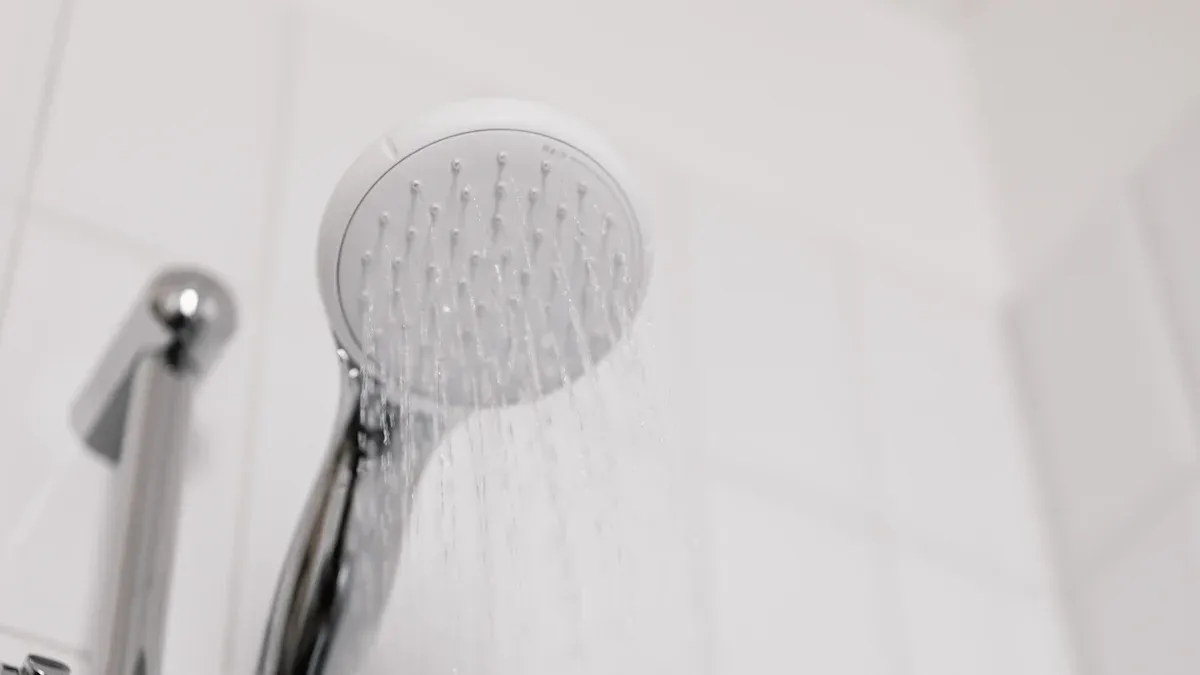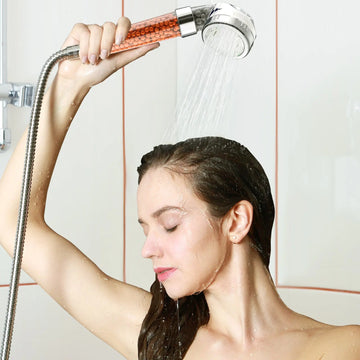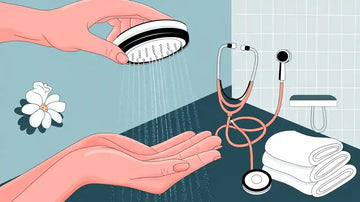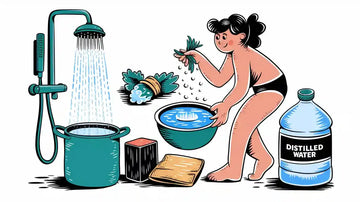Choosing the right shower head can make a big difference in your daily routine. High flow shower heads deliver a powerful stream, using between 2.5 to 5 gallons per minute. On the other hand, low flow models conserve water, using just 1.5 to 2.0 gallons per minute. If every home switched to low flow options, the U.S. could save over 260 billion gallons of water each year. Plus, you’d save up to 30% on energy costs annually. With 2025 regulations pushing for smarter water use, it’s time to rethink what works best for you.
Key Takeaways
High flow shower heads give strong water pressure for a fancy shower. But they use more water and raise your bills.
Low flow shower heads use less water, about 1.5 to 2.0 gallons a minute. They can save you up to $200 a year on water bills.
By 2025, many places will have stricter water rules. Shower heads must use 2.0 gallons per minute or less, so check your area's rules before buying.
New low flow shower heads still give good water pressure. They save water and are great for people who care about the planet.
Shower heads with the WaterSense label meet water-saving rules. They help you save money and protect the environment.
What Are High Flow and Low Flow Shower Heads?
High Flow Shower Head: Definition and Purpose
High flow shower heads give a strong, powerful water spray. They usually use more than 2.5 gallons of water per minute (GPM). If you enjoy a strong water stream, this type is for you. These shower heads make your bathroom feel like a spa. They are great for rinsing shampoo fast or enjoying a relaxing spray. But, they use more water, which means higher water and energy bills.
Low Flow Shower Heads: Definition and Purpose
Low flow shower heads are made to save water. They use 2.5 GPM or less, with some models using only 1.5 GPM! These are perfect if you want to save money and help the environment. Modern designs keep good water pressure with special technologies like aeration. They are also great if you live where water use is limited by rules.
Flow Rate Standards in 2025
In 2025, water flow rules are stricter than before. Many places now require shower heads to use 2.0 GPM or less. For instance, California allows only 1.8 GPM, while New York City and Colorado stick to 2.0 GPM. The federal limit is still 2.5 GPM. These rules help save water and energy. When buying a shower head, check your local rules to stay compliant.
Technological Advancements in Shower Head Design
Shower heads have improved a lot over time. In 2025, they are smarter and save more water. If you want comfort and eco-friendly features, there are great options. Let’s look at how new designs are changing showers.
Smart shower heads are a big improvement. They let you set water temperature and flow exactly how you like. Some even have timers to track water use. Imagine stepping into a shower already at your favorite temperature—no wasting water or adjusting knobs.
Eco-friendly designs are also important. New shower heads use special spray methods to save water but still feel powerful. You’ll get a strong stream while using less water. This helps both you and the environment.
Materials are getting better too. Many shower heads now use strong and green materials like titanium or recycled plastics. These last longer and are better for the planet. Picking eco-friendly materials is a small choice that helps a lot.
Here’s a simple table of these updates:
Innovation Type |
Description |
|---|---|
Smart Shower Heads |
Control water temperature and flow; track usage with timers. |
Eco-Friendly Innovations |
Save water with advanced spray designs while keeping comfort. |
Material Innovations |
Use strong, eco-friendly materials like titanium and recycled plastics. |
With these updates, showers can be more than just cleaning. They can be relaxing and good for the planet. Why not upgrade for a better experience?
Key Differences Between High Flow and Low Flow Shower Heads

Water-Saving Capabilities of Low Flow Shower Heads
Did you know that showers account for nearly 17% of indoor water use in most homes? That’s a lot of water going down the drain! Low flow shower heads are designed to tackle this issue by using 2.5 gallons per minute (GPM) or less. Some models even go as low as 1.5 GPM. By switching to these water-saving options, you can make a big difference. For example:
An average family can save up to 2,700 gallons of water each year with a WaterSense-labeled low flow shower head.
If every home in the U.S. made the switch, we could save over 260 billion gallons annually.
Not only does this help the planet, but it also saves money. Imagine cutting your water bill while doing your part for the environment.
Pressure and User Experience with High Flow Shower Heads
If you love a strong, invigorating shower, high flow shower heads might be your favorite. These models deliver more than 2.5 GPM, offering a luxurious experience that feels like a spa. They’re perfect for rinsing shampoo quickly or enjoying a relaxing spray after a long day.
However, you might wonder if low flow shower heads can match this level of comfort. Thanks to modern technology, many low flow options now maintain excellent shower pressure while using less water. So, you can still enjoy a satisfying shower without wasting resources.
Energy Efficiency and Environmental Impact
Low flow shower heads don’t just save water—they also save energy. Heating water takes a lot of energy, so using less water means using less energy too. Here’s a quick comparison:
Shower Head Type |
Water Usage (GPM) |
Energy Savings (%) |
Annual Cost Savings ($) |
|---|---|---|---|
Low-Flow |
Up to 30 |
Approximately 200 |
|
High-Flow |
2.5 - 5.0 |
N/A |
N/A |
Switching to a low flow shower head could save you up to $200 a year on energy costs. Plus, it reduces your carbon footprint. That’s a win-win for you and the planet!
By choosing the right shower head, you can balance comfort, savings, and sustainability.
Compliance with 2025 Regulations
Following the 2025 water rules is simpler than it seems. These rules help save water and stop waste. Many states now limit shower heads to 2.0 gallons per minute (GPM) or less. Some places, like California, have stricter rules at 1.8 GPM. Before buying a new shower head, check your local rules.
Low flow shower heads meet these rules while still working well. They use smart designs to keep strong water pressure but use less water. This way, you can enjoy a nice shower and help save water.
Tip: Choose shower heads with a WaterSense label. This label means the product meets federal water-saving standards and helps cut energy use.
Not following these rules might lead to fines or bigger water bills. Using a rule-following shower head is an easy way to help your community save water. Why not switch now?
Cost and Installation Considerations
When picking a shower head, think about cost and setup. Low flow shower heads are often cheap, with many under $50. They also save money over time by lowering water and energy bills.
Installing them is easy. Most low flow models are made for DIY setup. You just unscrew the old one, screw in the new one, and you’re done.
High flow shower heads may cost more at first. They also use more water, which raises monthly costs. If you want a high flow model, think about how much it will cost later.
Note: Some low flow models, like the Cobbe DS Filter Shower Head, mix water-saving with luxury. They give strong pressure, different spray settings, and are easy to install—all while saving water.
By comparing costs and benefits, you can pick the right shower head. Whether you want to save money, enjoy great performance, or both, there’s a perfect choice for you.
Advantages and Drawbacks of Each Type
Pros and Cons of High Flow Shower Heads
High flow shower heads are made for comfort and strong performance. If you enjoy a powerful spray, these are ideal. Here’s a breakdown:
-
Pros:
They provide strong water pressure for refreshing showers.
Many designs look stylish and improve your bathroom’s appearance.
They’re great for quickly rinsing shampoo or soap.
But there are some downsides:
-
Cons:
They use a lot of water, raising your utility bills.
Some models may not meet 2025 water-saving rules.
If you care about the environment, their impact might bother you.
Tip: Want a high flow shower head? Check local rules to avoid fines.
Pros and Cons of Low Flow Shower Heads
Low flow shower heads are designed to save water and energy while staying comfortable. They’re a great pick for eco-friendly homes. Here’s why:
-
Pros:
They use 2.0 gallons per minute (GPM) or less, saving water.
You’ll spend less on water and energy bills.
They follow water-saving laws, so no need to worry about rules.
Still, they have a few drawbacks:
-
Cons:
Some people might find the water pressure too weak.
You might need longer showers to rinse well, reducing savings.
Feature |
Low Flow Shower Heads |
High Flow Shower Heads |
|---|---|---|
Advantages |
- Save water and help the environment. |
- Strong jets for a spa-like shower experience. |
- Lower utility bills from using less hot water. |
- Quick rinsing saves time. |
|
- Meet water-saving regulations. |
||
- Use less energy by heating less water. |
||
Drawbacks |
- Weaker pressure may not suit everyone. |
- Higher water use means bigger bills. |
- Longer showers might reduce water savings. |
- Might not follow water-saving rules. |
Low flow shower heads have improved a lot. New designs give a good shower while saving water. If you want comfort and eco-friendliness, they’re a smart choice.
Which Shower Head Should You Pick in 2025?
Picking a Water-Saving Shower Head to Save Resources
Want to save water and lower your bills? A water-saving shower head is a smart choice. These shower heads use less water but still work well. They cut water use from 2.5-5 gallons per minute to just 1.5-2.0 gallons per minute. That’s a big change!
Here’s why they’re a great option:
They help save water, which is important in areas with shortages.
Using less water means heating less, saving up to 30% on energy costs yearly.
Families can save about $200 a year, making them a good investment.
These shower heads also meet 2025 rules, which limit flow rates to 2.0 GPM or less in many places. Some, like the Cobbe DS Filter Shower Head, mix water-saving with luxury. They offer strong pressure, different spray settings, and eco-friendly features in one product.
Tip: Choose shower heads with the WaterSense label. This ensures they meet federal water-saving and performance standards.
Choosing a High Flow Shower Head for Comfort
Do you enjoy a strong, spa-like shower? High flow shower heads might be perfect for you. They give powerful water pressure, making showers feel luxurious. They’re great for rinsing shampoo fast or relaxing after a long day.
New high flow designs now use advanced aeration. This mixes air with water for a fuller spray while still being mindful of water use. Some even have smart features to track water usage, letting you stay eco-friendly without losing comfort.
Here’s why they’re popular:
They offer different spray patterns to match your mood.
Modern designs combine comfort with sustainability.
Smart features show real-time water usage.
If you’re upgrading your bathroom for a touch of luxury, consider a high flow shower head. Just check local rules to make sure it’s allowed.
Affordable Shower Head Choices
You don’t need to spend a lot for a good shower head. Many budget-friendly options work well and meet water-saving standards. Low flow models often cost under $50 and are easy to install yourself.
When shopping on a budget, think about these things:
Flow rate: Make sure it’s 2.0 GPM or less to save water and energy.
Type: Pick between fixed, handheld, or dual shower heads based on what you need.
Durability: Look for strong materials like stainless steel or ABS plastic.
Even cheaper options can have features like multiple spray settings and filters. For example, the Cobbe DS Filter Shower Head has five spray modes and advanced filtration at a low price. It shows you can get quality without spending too much.
Note: Check for warranties and reviews to make sure you’re getting good value.
Following Regional Water Rules
Sticking to water rules in your area is simple. In 2025, many states have stricter limits for shower head water use. These rules help save water and lower waste. This benefits both the planet and your wallet.
Here’s how to follow the rules easily:
Know Your State’s Flow Limits
States have different water rules. California allows only 1.8 gallons per minute (GPM). New York and Colorado stick to 2.0 GPM. Check your state’s rules before buying a shower head. This avoids fines or penalties.Choose WaterSense-Labeled Shower Heads
Shower heads with the WaterSense label meet federal water-saving standards. They use 20% less water than the 2.5 GPM limit but still work well. Picking one ensures you follow the rules.Pick Shower Heads with Smart Features
Some models, like the Cobbe DS Filter Shower Head, include flow restrictors. These keep water use within legal limits while giving strong pressure. Many also offer extras like filters and spray options.
Tip: Unsure about your current shower head? Test its flow rate. Run water into a bucket for one minute. Measure the water to check if it meets your area’s GPM limit.
By following these tips, you can enjoy great showers while saving water. Switching helps both you and the planet! 🌍
Picking between high flow and low flow shower heads depends on your needs. High flow types give strong water pressure for a spa-like feel. Low flow ones save water and energy but still feel comfortable.
Think about what’s important to you. Do you want to save money and help the planet? Or do you enjoy a powerful, relaxing shower? Always check local rules to make sure your choice is allowed.
Tip: Try the Cobbe DS Filter Shower Head. It mixes strong pressure, filtration, and water-saving features. Upgrade your shower today!
FAQ
What’s the difference between high flow and low flow shower heads?
High flow shower heads deliver strong water pressure, using more water per minute. Low flow models save water and energy while maintaining decent pressure. If you want luxury, go high flow. If conservation matters to you, low flow is the better choice.
Can low flow shower heads still provide good pressure?
Absolutely! Modern low flow shower heads use advanced technology like aeration to keep the pressure strong. You’ll enjoy a satisfying shower while saving water.
Are high flow shower heads allowed under 2025 regulations?
It depends on your location. Some states limit shower heads to 2.0 GPM or less. Check your local rules before buying a high flow model to avoid fines.
How do I install a new shower head?
Most shower heads are easy to install. Unscrew the old one, clean the threads, and screw in the new head. Models like the Cobbe DS Filter Shower Head come with user-friendly designs for quick setup.
Is the Cobbe DS Filter Shower Head worth it?
Yes! It combines luxury, filtration, and water-saving features. With five spray modes and a 20-stage filter system, it’s perfect for eco-conscious users who want a spa-like experience.







